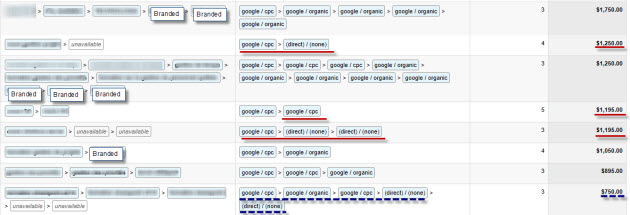Evaluate the ROI of your keyword buying campaign using multi-channel Google Analytics.
We are all able to calculate an ROI, it is the cornerstone of online advertising.
(Revenue-Cost)/Cost
If we only had one online traffic source, it would be awfully simple to calculate its ROI and I wouldn't bother you with an article about it. On the other hand, anyone who has already analyzed the traffic sources of a transactional site knows that this is not the case. Multiple sources converge towards a single goal: conversion. Yours. The one for which you spend money and effort. Now you can follow it from start to finish.
Important facts to note:
- Several traffic sources generate visits to your site.
- Not all of your visitors convert the first time.
- Your site visitors will come to your site through different sources.
Not so long ago, only the last source was considered in GA. Imagine the following situation: a visitor arrives via the purchase of keywords and returns 2 days later via organic SEO to make a purchase. Without multi-channels, this purchase would have been attributed to organic SEO.
Now multi-channels are a game changer. It is possible for us to analyze users according to the paths they take.
Here is a simple example:
![]()
Mid-complex:

And the example of a client who has severe decision problems:

In short, the more the path becomes more complex, the fewer the customers who take it. In the latter case, only one client has taken such a path in the last month. Please note that conversion funnels are based on the 30 days prior to conversion in order to calculate the paths taken by the user.
The heart of the matter, the crispness, which will make PPC specialists salivate.
In CPD, we know our [great] usefulness, but sometimes had difficulty demonstrating it. Now here is what it is possible to do thanks to multi-channels:

In this table, without the multi-channel contribution, only $4,390.00 would be attributable to PPC out of a total of $9,335.00. What's more, it is now possible to segment conversions that begin with broad searches relating to the subject of your site, and ending with a search for corporate keywords (line 1,3 and 6) which is, in short , pure and simple customer acquisition that we did not suspect before the arrival of multi-channels.
Remember that PPC is the first source of conversion and that this conversion might not have taken place without this advertising. We call this "Assisted conversions" (The number of conversions for which this channel appeared on the conversion path, but was not the final conversion interaction). Here is an example with a total PPC sales of $37,250:

Let’s be clear, of all the conversions that started with PPC, it is now possible to clearly identify all the conversions ending with another source. The ROI of PPC campaigns tends to increase drastically. I invite you to see it in your GA account.
Advice :
If you are importing your conversions from GA, it is more than important to use this tool for the above reasons. On the other hand, if you use the Adwords conversion chip, you will not see a difference in the amounts of income, but you will surely learn a lot about the habits of your customers.
Have fun…
For Geekos:
In addition, in order to improve the attribution of traffic sources in multi-channels, Google Analytics has changed the way it calculates a session for a visitor. I invite you to read my colleague Simon's post.




